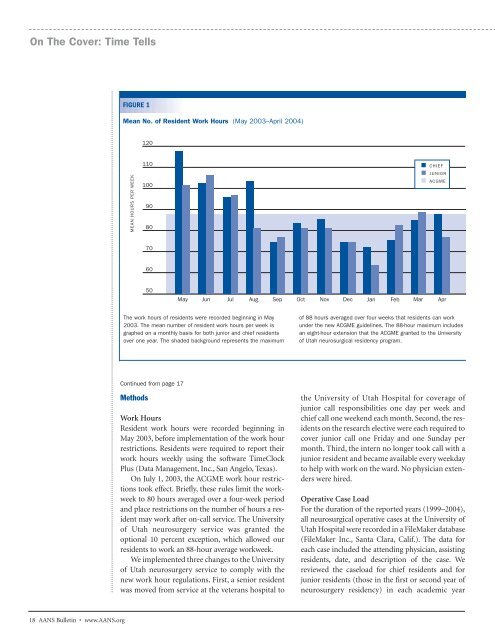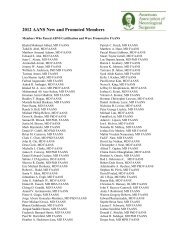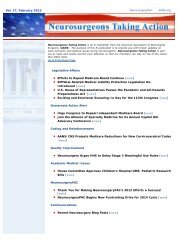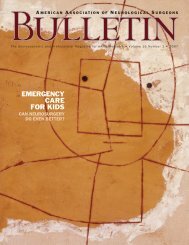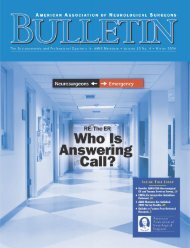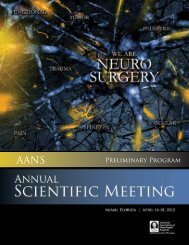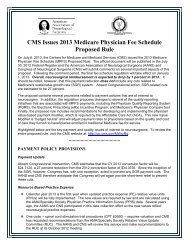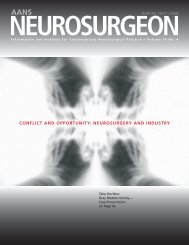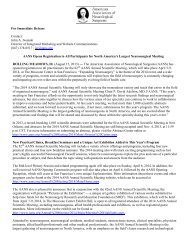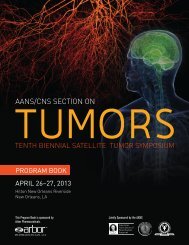view PDF - American Association of Neurological Surgeons
view PDF - American Association of Neurological Surgeons
view PDF - American Association of Neurological Surgeons
Create successful ePaper yourself
Turn your PDF publications into a flip-book with our unique Google optimized e-Paper software.
On The Cover: Time Tells<br />
FIGURE 1<br />
Work Hours (May 2003-April 2004)<br />
Mean 130 No. <strong>of</strong> Resident Work Hours (May 2003–April 2004)<br />
120<br />
MEAN HOURS PER WEEK<br />
110<br />
100<br />
90<br />
80<br />
CHIEF<br />
JUNIOR<br />
ACGME<br />
70<br />
60<br />
50<br />
May Jun Jul Aug Sep Oct Nov Dec Jan Feb Mar Apr<br />
The work hours <strong>of</strong> residents were recorded beginning in May<br />
2003. The mean number <strong>of</strong> resident work hours per week is<br />
graphed on a monthly basis for both junior and chief residents<br />
over one year. The shaded background represents the maximum<br />
<strong>of</strong> 88 hours averaged over four weeks that residents can work<br />
under the new ACGME guidelines. The 88-hour maximum includes<br />
an eight-hour extension that the ACGME granted to the University<br />
<strong>of</strong> Utah neurosurgical residency program.<br />
Continued from page 17<br />
Methods<br />
Work Hours<br />
Resident work hours were recorded beginning in<br />
May 2003, before implementation <strong>of</strong> the work hour<br />
restrictions. Residents were required to report their<br />
work hours weekly using the s<strong>of</strong>tware TimeClock<br />
Plus (Data Management, Inc., San Angelo, Texas).<br />
On July 1, 2003, the ACGME work hour restrictions<br />
took effect. Briefly, these rules limit the workweek<br />
to 80 hours averaged over a four-week period<br />
and place restrictions on the number <strong>of</strong> hours a resident<br />
may work after on-call service. The University<br />
<strong>of</strong> Utah neurosurgery service was granted the<br />
optional 10 percent exception, which allowed our<br />
residents to work an 88-hour average workweek.<br />
We implemented three changes to the University<br />
<strong>of</strong> Utah neurosurgery service to comply with the<br />
new work hour regulations. First, a senior resident<br />
was moved from service at the veterans hospital to<br />
the University <strong>of</strong> Utah Hospital for coverage <strong>of</strong><br />
junior call responsibilities one day per week and<br />
chief call one weekend each month. Second, the residents<br />
on the research elective were each required to<br />
cover junior call one Friday and one Sunday per<br />
month. Third, the intern no longer took call with a<br />
junior resident and became available every weekday<br />
to help with work on the ward. No physician extenders<br />
were hired.<br />
Operative Case Load<br />
For the duration <strong>of</strong> the reported years (1999–2004),<br />
all neurosurgical operative cases at the University <strong>of</strong><br />
Utah Hospital were recorded in a FileMaker database<br />
(FileMaker Inc., Santa Clara, Calif.). The data for<br />
each case included the attending physician, assisting<br />
residents, date, and description <strong>of</strong> the case. We<br />
re<strong>view</strong>ed the caseload for chief residents and for<br />
junior residents (those in the first or second year <strong>of</strong><br />
neurosurgery residency) in each academic year<br />
18 AANS Bulletin • www.AANS.org


